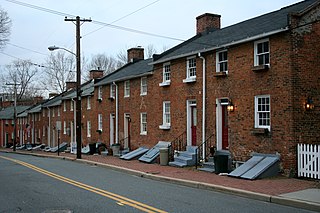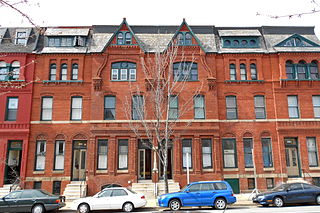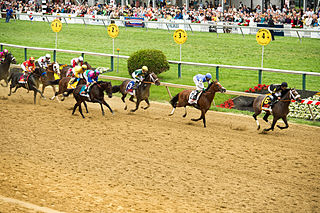Related Research Articles

Riverview Park was an amusement park in Chicago, Illinois, which operated from 1904 to 1967. It was located on 74 acres in an area bound on the south by Belmont Avenue, on the east by Western Avenue, on the north by Lane Tech College Prep High School, and on the west by the North Branch of the Chicago River. It was located in the Roscoe Village neighborhood of Chicago's North Center community area.

North Center is one of the 77 community areas of Chicago, Illinois, located in the city's North Side. North Center is bordered on the north by Montrose Avenue, on the south by Diversey Parkway, on the west by the Chicago River and on the east by Ravenswood Avenue; it includes the neighborhoods of North Center, Roscoe Village, St. Ben's, and Hamlin Park. The Brown Line of the Chicago 'L' has stops within the community area at Addison, Irving Park, and Montrose.

Oella is a mill town on the Patapsco River in western Baltimore County, Maryland, United States, located between Catonsville and Ellicott City. It is a 19th-century village of millworkers' homes.

Lansdowne is a census-designated place in southern Baltimore County, Maryland, United States, located just south of Baltimore. As of the 2010 census, it had a population of 8,409. At the 2000 census and earlier, the area was delineated as part of the Lansdowne-Baltimore Highlands CDP.

Baltimore Highlands is a census-designated place (CDP) in Baltimore County, Maryland, United States, directly south of the city of Baltimore. The population was 7,019 at the 2010 census. At the 2000 census and earlier, the area was delineated as part of the Lansdowne-Baltimore Highlands CDP.

The Station North Arts and Entertainment District is an area and official arts and entertainment district in the U.S. city of Baltimore, Maryland. The neighborhood is marked by a combination of artistically-leaning commercial ventures, such as theaters and museums, as well as formerly abandoned warehouses that have since been converted into loft-style living. It is roughly triangular, bounded on the north by 20th Street, on the east by Greenmount Avenue, and on the south and west by the tracks of Amtrak's Northeast Corridor, though the neighborhood's boundaries include a one-block wide extension over the tracks.

Pimlico is a neighborhood in Baltimore, Maryland. It is the site of Pimlico Race Course, which holds the Preakness Stakes, one of the three legs of the Triple Crown of Thoroughbred Racing. From 1896 through 1915, Pimlico was also the home of Baltimore's Electric Park, a popular amusement park located near the intersection of Reisterstown Road and Belvedere Avenue.

Carrollton Ridge is a neighborhood of South Baltimore, Maryland, United States

Ellwood Park is a neighborhood in the eastern part of Baltimore, Maryland. It is named for a small public park with a playground between Jefferson and Orleans Streets. The neighborhood extends from Linwood Avenue and Haven Street, between Monument Street and Fayette Street. It is contained within the 21205 and 21224 zip code.
Deer Creek is a 52.9-mile-long (85.1 km) river in Maryland and Pennsylvania that flows through the scenic areas of Harford County and empties into the Susquehanna River, roughly halfway between the Interstate 95 bridge and Conowingo Dam. Its watershed area is 171 square miles (440 km2). Its watershed area in MD is 145 square miles (380 km2), with 3% impervious surface in 1994. It serves as a divider between the agricultural and urban/suburban areas of Harford County.

Sandtown-Winchester is a neighborhood in West Baltimore, Maryland. Known locally as Sandtown, the community's name was derived from the trails of sand that dropped from wagons leaving town after filling up at the local sand and gravel quarry back in the days of horse-drawn wagons. It is located north of Lafayette Street, west of Fremont Avenue, south of North Avenue, and east of Monroe Street, covering an area of 72 square blocks, patrolled by the Baltimore Police Department's Western District. The community is 98.5% black.

Greenmount West is a neighborhood in the state-designated Station North Arts District of Baltimore City. Its borders consist of Hargrove Alley to the west, Hoffman Street and the Amtrak railroad tracks to the south, the south side of North Avenue to the north, and Greenmount Avenue to the east. Residents in the area include a mix of low, middle and high income families, artists, commuters to Washington DC and working-class Baltimoreans with the majority of residents of African American descent.

Gwynn Oak Park is a park that was the site of a privately owned amusement park, located in the community of Gwynn Oak, just outside northwest Baltimore, Maryland, in Baltimore County. The 64-acre (260,000 m2) park is at the corner of Gwynn Oak and Gwyndale avenues, about a quarter mile off of Liberty Heights Avenue. The amusement park, which existed from 1893 until 1973, was the site of protests against racial segregation due to a whites-only admissions policy.


Fullerton is an unincorporated community in Baltimore County, Maryland, United States. The area is often considered part of Nottingham, despite being part of Overlea. Fullerton residents have either 21236 or 21206 as their ZIP code.

The community of Wyman Park is a border community that links Hampden to Roland Park. All of the Wyman Park areas were annexed to Baltimore City in 1888. The general boundaries consist of the area from south to north between 33rd Street and 40th Streets and west to east from Keswick Road to Wyman Park, which includes the southern portion of the Stony Run Trail. South of 40th Street, garden apartments, multi-story apartment buildings, and single-family residences have been built. People here tend to relate to the north along 40th Street and University Parkway and Johns Hopkins University.
Riverview Park may refer to:
Riverview Park was an amusement park in Des Moines, Iowa, from 1915 to 1978. What began in pre-1915 as a zoological garden and trolley destination in an area of Des Moines known as Highland Park would become Riverview Amusement Park, a popular family entertainment oasis in early Iowa history. It was built upon an island, accessed via a wooden bridge, by a group of nine local businessmen that were headed up by a Des Moines movie-theater mogul named Abe Frankle. In the early years various entertaining events and attractions that made Riverview Park a fondly remembered family get-away included free acts featuring death-defying daredevils and musical band concerts. The early amusement rides included in 1923 a new carousel (PTC#65) from the Philadelphia Toboggan Company, whose carousels represented some of the finest examples of hand carved carousel horses in America, and a large Carousel Pavilion building to house it. In 1928 a Herschell-Spillman menagerie carousel with intricate hand-carved animals replaced the PTC carousel. In 1920 John Miller–designed a figure-eight roller coaster featuring eight full dips that all went to the ground level for the park. In 1940, the Riviera Ballroom was added and provided big band dances throughout the 1940s and 1950s and teen dances in the 1960s and 1970s. The Riviera Ballroom was inducted into the Iowa Rock and Roll Hall of Fame in 2010.

Oriole Park, often referred to as Terrapin Park, opened in 1914 and closed after a fire on July 3–4, 1944. "Oriole Park" was the name of multiple baseball parks in Baltimore, Maryland, all built within a few blocks of each other.
Carlin's Iceland was an indoor artificial ice arena in Baltimore, Maryland, that was part of a city amusement park, known as Carlin's Park. It opened in December 1931, and was Baltimore's first indoor rink. The building was converted from a ballroom, to an ice surface measuring 85 × 120 ft, and seating for 1,200 people. In the first winter of operation, Iceland hosted school teams, before it was expanded for the following season. The Baltimore Orioles in the Eastern Amateur Hockey League played at Carlin's from 1932 to 1942. In its renovated setup, Iceland held 3,000 spectators, hosted annual winter carnivals, and once hosted a Sonja Henie show.
References
- ↑ Zajac, Mary K. (August 2007). "Wild Ride". Baltimore Style Magazine. Retrieved 30 August 2012.
- ↑ Schaaf, Elizabeth (1999). "The Storm is Passing Over". The Archives of the Peabody Institute of The Johns Hopkins University. Retrieved 30 August 2012.
- ↑ Adam Paul and Ira Wexler. "Amusement as Close as the Car Line" . Retrieved 30 August 2012.
39°15′37″N76°32′38″W / 39.26028°N 76.54389°W